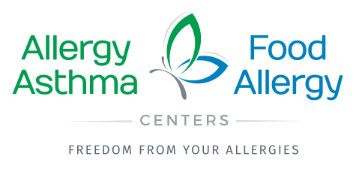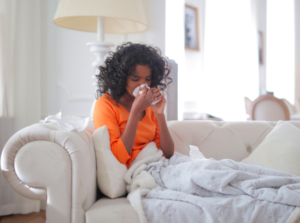Interested in Allergy Shots or Drops for Environmental Allergies?
Explore Which Option Is Best For You
How Do They Work?
- Both allergy shots and sublingual drops are forms of allergen immunotherapy (IT). IT is the only treatment option available that decreases your immune system’s response to your allergens.
- The allergen is shown to your body in miniscule amounts and then gradually increased over time. Through this process, your body learns to “tolerate” the allergen rather than view it as a threat. As this occurs, symptoms such as sneeze, runny nose, congestion, watery itchy eyes, and cough diminish.
Why Do Them?
- The goal of allergy injections and drops is to significantly reduce allergy symptoms and medication use.
- Some patients start IT because medications do not work well enough. Other patients start because they are looking for a more long-term option or wish to treat the “root of the problem.” Medications help reduce symptoms while you are on them, but they do not prevent future symptoms as shots or drops do.
What Are The Options?
- Allergy Injections:
Allergy injections are started weekly, then transitioned to every 2 weeks for 1o injections, then every 3 weeks for 10 injections and then every 4 weeks (maintenance). You will either be 1, 2 or 3 vials (shots) depending on your number and combination of allergens. There are 2 build-up options: Traditional and Cluster.
Traditional Build Up:
- The goal dose is reached in about 1 year.
- TIP: If you come 2x weekly, you will build-up in half the time and if you come 3x weekly, you will build-up in a third of the time.
- Each time you come, you receive 1 dose.
- There is a 30 minute observation period after injections to monitor for an allergic reaction.
- Standard injection hours apply (Shot calendars).
Cluster (Accelerated Build-Up):
- The goal dose is reached in about 9 weeks, because you get multiple injection doses in one day.
- For the first 8 injections, you will receive 2-3 doses.Cluster & Venom Immunotherapy Build-up
- The 30 minute wait applies after each injection.
- For 3 dose days, plan to be in the office at least 90 minutes.
- For 2 dose days, plan to be in the office for at least 60 minutes.
- During the initial build-up phase (where 2 or 3 doses are administered), the “cluster” injection schedule hours apply. Once the goal dose is reached, standard injection hours apply.
- Sublingual Drops
- Drops are administered under the tongue at home and are taken daily.
- The extracts are FDA approved, but sublingual administration of the extracts is not FDA approved. Thus, sublingual therapy is not covered by insurance.
- Efficacy not high as with injections.
- Allergens can be combined, but not as many as with injections. For patients with multiple allergies, discuss with your provider which option may be best for you.
How Long Do You Continue Therapy?
- Injections or sublingual drops are typically recommended for 3 – 5 years. The extended duration is to help create lasting changes to the immune system, so that you maintain the benefits long after you stop therapy.
When Is The Best Time To Start?
- Injections or sublingual drops take several months to start working and can take up to a year or more to reach full efficacy. Starting months before your peak allergy season is ideal, but injections can be started at any time of the year.
- Patients 3 years of age and older are candidates.
Is Immunotherapy Covered By Insurance?
- Injections are typically covered by insurance, though the cost to you will be determined by your specific plan and your deductible. We can provide general pricing information.
- Sublingual drops are unable to be billed to insurance. Costs are Out of Pocket and range from $85 to $145 per month. Additional information can be found here.
How Often Are Office Visits?
- The first injection or sublingual dose will require an office visit, but all other injection visits are walk-in without an office visit. After the first dose, injections are not scheduled. You are not assigned a designated day or time. You may come at your convenience during our shot hours (Injection Calendar).
- There will be routine visits during the build-up phase of injections or sublingual drops. After the goal dose is reached, office visits are required at least once annually.
What If I Will Be Out Of Town Or Miss Injections?
- If you miss an injection or are late for an injection, a dose adjustment will be made if needed. Injections would typically only need to be restarted if there was a very prolonged gap between injections.
- If you anticipate a number of missed doses or problems coming in for injections, sublingual drops may be a more convenient option for you.
What Are Next Steps If I Wish To Start Injections or Drops?
- Discuss your history and goals directly with your provider during a visit.
- Once you and your provider have decided on a treatment plan, please complete and return the consent forms. After the consent forms are received, your vials will be mixed and we will contact you to schedule your first dose. Please allow at least 2 weeks for mixing. For sublingual drops, payment must be received prior to mixing. NOTE: Please do NOT return the consents unless you are certain you want to start IT, as vials are mixed once the consents are received.
Special Circumstances
- Injections or sublingual drops should not be started if you are pregnant. If you are on injections or drops and become pregnant, you will be held at your current dose for the duration of your pregnancy.
- You should tell your provider if you are on a medication called a Beta Blocker. This class of medications is prescribed for conditions such as high blood pressure, migraines, tremors and anxiety. Examples include propranolol, atenolol and metoprolol.
- Out of office administration of injections by a medical professional is permitted in specific circumstances, for example when a patient on injections is away at college. An “Off Site Injection” policy will apply.
Immunotherapy Options At a Glance
| Injections | Sublingual Drops | ||
| Location | Office | Home | |
| Administration | Injected into arm | Liquid administered under tongue | |
| Efficacy | Excellent | Good | |
| Multiple Allergies | Best | Fair/Good | |
| Side Effects | Local reactions. Systemic reactions uncommon (< 0.1%). | Itchy mouth/throat. Systemic reactions very uncommon. | |
| Frequency Of Dosing | Every 1-4 weeks per protocol (weekly to start) | Daily | |
| FDA Approved | Yes | No | |
| Insurance Coverage | Yes | No | |
| Cost | Will depend on insurance | $85 – $145 per month | |
Harold S. Nelson, MD; Subcutaneous Immunotherapy Versus Sublingual Immunotherapy: Which is More Effective? Journal of Allergy and Clinical Immunotherapy, April 2014



